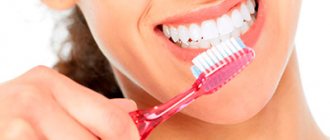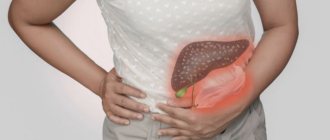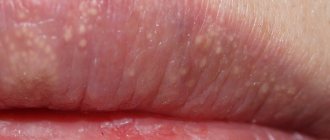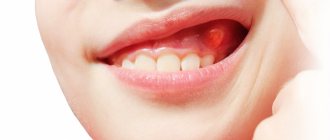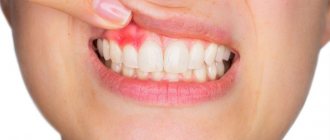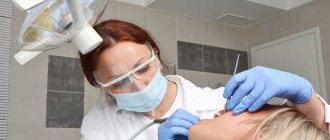Modern people have a fast pace of life, everyone has a lot of things to do, meetings, and obligations. Therefore, most of us tend to ignore minor symptoms such as an aching tooth, pain when biting, or reddening of the gums. As a result: tooth inflammation, pain, discomfort, postponed meetings and rescheduled plans.
Content
- How inflammation manifests itself
- What is the danger of tooth inflammation
- What can you do at home?
- What will they do at the hospital?
- Is it possible not to go to the dentist?
- Prevention
Tooth inflammation is an unpleasant and dangerous event that requires an immediate response. Inflammation can start for many reasons. There are always bacteria in the mouth. Under favorable conditions, they begin to multiply and can damage tissue. Based on sufficient hygiene and preventive actions, a small inflammation of the soft tissues can develop into a much more dangerous complication - inflammation of the tooth.
To understand how to treat tooth roots, pay attention to the symptoms!
Root canal treatment is only required when x-rays show that the pulp has been damaged by a bacterial infection. If soft tissue becomes infected with bacteria, it begins to die, allowing the bacteria to multiply and spread further.
Symptoms of a pulp infection include:
- pain when eating, drinking hot or cold foods and drinks
- pain when biting or chewing
- shaky/loose condition of the tooth in the gum
As the infection progresses, these symptoms often disappear temporarily as the soft tissue dies. You may think that the tooth has recovered, but in fact the infection is spreading through the root canal system into the jaw bone.
Eventually, the symptoms return, but in a different form and can cause the following complications:
- Increased and longer-lasting pain returns, even when pressing on the tooth
- the gums near the affected tooth swell
- pus oozes from the affected tooth
- Facial swelling occurs
- the tooth becomes darker in color
It is very important to consult a dentist before the above symptoms occur, even at the stage of increased sensitivity and minor pain. If your tooth is infected, the pulp cannot heal on its own. Leaving an infected tooth alone can make the situation worse, while reducing the chances of successful root canal treatment
Antibiotics (drugs to treat bacterial infections) are ineffective in treating dental root canals. Look at prices for tooth root treatment (endodontic treatment)
How does tooth inflammation manifest?
The first signs of acute inflammation are:
- Redness of the gums around the tooth.
- Swelling.
- Pain when biting, pressing, and later without it.
- Sensitivity to temperature changes, sour, sweet.
- Enlargement of regional lymph nodes.
- Bleeding gums.
If the inflammation has progressed to a chronic stage, the patient may observe:
- Increase in temperature (local or general).
- Weakness.
- Intense pain.
- Inflammation is manifested in the results of clinical tests.
PROMOTION
Hygienic teeth cleaning
2000 rub.
Main features
- Pain
In each case it can manifest itself differently. Sometimes it is pain when biting, sometimes it is continuous. It may get worse at night and subside with meals. It can radiate to the temple, ear, even nose. Being whiny or harsh.
- Redness
It may or may not be visible. This is a symptom that is more often detected by a doctor.
- Edema
Any inflammation is accompanied by swelling, but we cannot always determine this.
- Temperature increase
This doesn’t always happen, but fever is a sign of inflammation, so in this case you definitely shouldn’t put off going to the dentist.
- Tumor
This is also a dangerous signal; you need to see a doctor urgently.
If a tooth is inflamed and hurts, temporary measures will not help; you need a full diagnosis and treatment in a clinic. The alternative is tooth loss due to an advanced process.
How dangerous is tooth inflammation?
Inflammation, especially if left untreated, affects not only the tooth itself, but also the tissue around it. Lack of treatment is dangerous for many reasons:
- The patient may lose a tooth.
- Inflammation negatively affects the entire body, adversely affecting the functioning of the kidneys, heart and other systems.
- The infection that caused the inflammation will spread, causing flux, bone inflammation, purulent abscesses, osteomyelitis, and sepsis.
- The disease can spread, affecting adjacent teeth and periosteum.
Inflammation of the gums due to gingivitis and periodontitis –
With gingivitis, the patient complains of swelling, redness or cyanosis of the gingival margin and interdental gingival papillae, bleeding and soreness of the gums when brushing teeth, and bad breath (Fig. 1-2). The development of gingivitis is associated with a microbial factor, i.e. when, against the background of not very good oral hygiene, soft microbial plaque accumulates in the area of the necks of the teeth and hard tartar forms.
Pathogenic bacteria from soft microbial plaque and hard tartar produce toxins and inflammatory mediators, which cause inflammation in the gums. Please note that with gingivitis, inflammation affects only the gingival margin and is not accompanied by destruction of the periodontal attachment or bone tissue around the teeth. But if at this stage the causative factor of inflammation (microbial plaque and tartar) is not removed, then over time the destruction of the dentogingival attachment, the bone tissue around the teeth, as well as the periodontal attachment of the roots of the teeth to the bone occurs. All this already indicates the transformation of gingivitis into “chronic periodontitis”.
Inflammation of the gums (chronic periodontitis) –
Periodontitis is still characterized by all of the above symptoms of gingivitis + over time, tooth mobility appears, during periods of exacerbations, purulent discharge may be released from under the gums, the roots of teeth gradually become exposed, and also in severe stages of periodontitis, fan-shaped divergence of teeth occurs (Fig. .5-6).
Inflammation of the gums: treatment for gingivitis and periodontitis
If the patient complains of generalized inflammation of the gums, treatment for gingivitis and periodontitis begins with the procedure for removing dental plaque, and immediately after this a course of anti-inflammatory therapy is prescribed. Bacterial plaque and tartar can only be removed from teeth by a dentist, and usually ultrasonic teeth cleaning is used for this (Fig. 7-8). However, the course of anti-inflammatory therapy itself can be carried out at home, and for this, the dentist will prescribe you a course of antiseptic rinses and gel applications to the gums.
Ultrasound removal of dental plaque: photo
ANTI-INFLAMMATORY THERAPY SCHEME:
Let's now see how to treat gum inflammation with medication, and first of all, antiseptic rinses and gel applications to the gums will help us with this. But you must understand that if you decide to neglect the stage of removing dental plaque at the dentist and start with drug therapy, this will only temporarily suppress the symptoms, but will not stop the destruction of the attachment of the gums to the teeth (which will simply be more asymptomatic).
1) Antiseptic rinses - drug treatment of gum inflammation usually lasts - 7-8 days for gingivitis and 10 days for periodontitis. We will need an antiseptic solution for rinsing the mouth (usually chlorhexidine is prescribed), as well as an anti-inflammatory gel for the gums. Gum treatment is carried out 2 times a day (morning and evening), and it is important to do it only after meals and subsequent oral hygiene. And precisely in this sequence, and not vice versa!
Thus, in the morning you should have breakfast, brush your teeth and then rinse your mouth with an antiseptic chlorhexidine solution. To do this, you must take 10 ml of solution into your mouth (about 1 sip) and, without spitting, rinse your mouth for a full 1 minute. Next, spit out the solution and under no circumstances rinse your mouth with water! An important issue is the effective concentrations of chlorhexidine, and you can read more about this at this link (this article provides reasoning and links to clinical studies).
With gingivitis, everything is quite simple, and if you have removed plaque from your teeth at the dentist, then, in principle, the usual inexpensive solution of 0.05% chlorhexidine, which is sold in any pharmacy for 30-40 rubles, will be more or less effective (although it is considered optimal to use at least 0.12% chlorhexidine). But if we are talking about periodontitis, then the minimum effective concentration should be at least 0.2%. Products containing 0.2-0.25% chlorhexidine are more expensive, for example, Parodontax Extra mouthwash with 0.2% chlorhexidine will cost from 210 rubles per 300 ml bottle.
2) Application of gel to the gums - immediately after rinsing, we need to apply a special anti-inflammatory gel to the gums. The best medicine for gum inflammation for these purposes is Cholisal gel, which copes with inflammation very quickly, but it costs about 470 rubles (per tube of 15 g). At the same time, you will need 1 tube for the course of treatment of gingivitis, and 2 tubes of the drug for the course of treatment of periodontitis. If this is expensive, then you can use Parodontocid gel, which is certainly weaker than Cholisal, but it will work well if you combine it with 0.2% chlorhexidine.
The gel is applied to the gingival margin around the necks of the teeth and interdental gingival papillae using the tip of the index finger. First, it is advisable to apply the gel around the lower teeth, then around the upper ones (note that the gel must be applied not only from the front surface of the teeth, but also from the palate/tongue). The gel will adhere better to the moist mucous membrane if you first dry the gingival margin with a dry gauze swab. It is better to treat the gingival margin from the front surface of the teeth in 2 stages (24stoma.ru).
Those. First, you rub small portions of the gel into the gum margin (using light massaging movements), after which you apply the gel without massage and leave it on the gum. The gel can be applied to the gingival margin from the palate/tongue only once, rubbing small portions of the gel with light massaging movements. Another option for applying the gel is using a thin medical (dental) spatula or applicator. After applying the gel, it is advisable not to drink for at least 30 minutes, and you should not rinse your mouth or eat food for at least 2-3 hours.
Important: during the application of the gel, saliva may be actively released, but it does not need to be accumulated in the mouth or spat out. Saliva should be swallowed as you usually do. In the evening, repeat the treatment in the same sequence (dinner → oral hygiene → antiseptic rinse → applying gel to the gums). And you should do this for 7-8 or 10 days, depending on the type of gum inflammation.
Important:
- With gingivitis, only the marginal part of the gum is affected by inflammation, so the above-mentioned anti-inflammatory course and preliminary removal of dental plaque is quite sufficient to completely stop the inflammation in the gums.
But to prevent inflammation from occurring again, it is very important to maintain proper oral hygiene. Below at the link you can read comprehensive information on the forms of gingivitis and their treatment - → Algorithm for the treatment of gingivitis - For periodontitis , i.e.
when the symptoms of gingivitis are accompanied by tooth mobility, exposure of roots, suppuration from periodontal pockets - just removing dental plaque and the above course of anti-inflammatory therapy will no longer be enough. This may additionally require antibiotic therapy, washing of periodontal pockets, splinting of mobile groups of teeth, as well as surgical treatment methods. Read more about this in the article – → Algorithm for the treatment of periodontitis
What can you do at home?
The first thing you need to do is make an appointment with a dentist. While waiting for an appointment, the patient may be able to cope with some symptoms. To do this you can do:
- Rinse your mouth with a soda solution (you can add salt and iodine).
- Minimize exposure to the affected area, do not chew on the affected side.
- Avoid hot and cold exposure.
- If the bite is incorrect, it is better to keep the jaws slightly open.
- You can take a pain reliever.
- You should not take a lying position, as this will increase the pressure in the adjacent vessels. It is better to recline or sit.
- Antibiotics should not be taken without a doctor's prescription.
- Under no circumstances should you heat the site of inflammation, since with a purulent abscess there is a possibility of its contents spilling into the soft tissue.
These measures are aimed solely at combating symptoms and do not replace professional treatment by a dentist.
What will they do in the hospital: diagnosis, treatment
First of all, the doctor needs to determine the diagnosis and cause of the inflammation. To do this, radiography is performed to determine what stage the process is at.
The main factors leading to inflammation are:
- Advanced caries, due to which an infection has entered the tooth.
- Incorrect treatment (poor canal filling, bad filling), which also leads to infection.
- Injuries, root fracture, etc.
- Insufficient hygiene.
If the situation is neglected, there is a possibility of immediate removal of the diseased element.
If treatment is possible, first of all, the diseased tooth is cleaned of damaged tissue. The procedure requires the administration of anesthesia. The doctor will clean the canals, expand them if necessary, and disinfect them. If necessary, the patient takes a course of antibiotics, rinses with disinfectant solutions, and physiotherapy. A special substance may be placed into the tooth as a temporary filling. After there is no inflammation or pus left in the tooth, it can be sealed with a permanent filling.
Causes
Accurate diagnosis is important for a positive treatment outcome. It is this that allows you to determine why the tooth is inflamed. There are 3 diseases hidden under the general term.
Pulpitis
Microbes penetrate through the dentin layer to the neurovascular bundle - the pulp. People call it a nerve. Usually, this happens with deep caries. The pulp is penetrated by nerve endings. The pain is often acute and difficult to endure. But sometimes it is not strong, periodic. We ignore it and the inflammation becomes chronic, destroying the pulp. A small bun makes a huge difference:
- produces secondary dentin, therefore, although the height of the teeth changes throughout life, they do not disappear completely;
- participates in tissue metabolic processes;
- conducts nerve impulses.
When the pulp dies, the tooth is said to become “dead.” Such teeth are quickly destroyed.
To treat pulpitis in dentistry, therapeutic and surgical methods are used. In the first case, medications are placed into the tooth cavity and closed with a temporary filling. After some time, the tampon with the medicine is removed and the tooth is filled. This method does not always help relieve inflammation inside the tooth.
If the process has gone far, the pulp or part of it is removed and then a permanent filling is placed.
Periodontitis
Under the crown of the tooth there is connective tissue - periodontium. As a result of injury or poor treatment, microbes penetrate there, causing inflammation of the tooth root - periodontitis.
.
There is an apical form, when only the apex is affected, and a marginal form, when all the tissue around the root is infected.
Symptoms of periodontitis:
- pain while eating or when jaws touch;
- feeling that the tooth stands out from the row (has become taller);
- temperature increase;
- tissue redness;
- tooth mobility;
- discharge of pus.
Periodontitis is an insidious enemy. Often the disease occurs without symptoms. It can only be suspected when the signs of the disease become pronounced: roots are exposed, gums bleed, pus is released, bone tissue decreases.
Treatment depends on the type of periodontitis and severity:
- Therapeutic method
The doctor opens access to the root canals, removes part or all of the pulp, and installs drainage to drain the pus. After a few days, the drainage is removed, the canals and tooth are processed and filled. It is recommended to place a crown on such a tooth.
- Surgical method
They resort to it if fibrosis has developed or there are granulomas.
Dentist:
- Cuts off the root tip
- Removes 1 root in multi-rooted teeth
- Amputates the root but leaves the crown intact
- Removes a tooth
- Performs separation (cuts the tooth in half, cleans it and puts it back together)
A course of antimicrobial tablets helps relieve inflammation inside the tooth.
Periodontitis
Periodontium is the fibers that hold the tooth in its socket. Plaque allows bacteria from it to penetrate into the periodontium and begin to rapidly multiply, forming a periodontal pocket. From the pocket, it is easy for them to get under the crown of the tooth and cause an inflammatory process there.
Before treating tooth inflammation under the crown, periodontal pockets are curetted, freeing the surface from tartar and plaque. Then they begin other manipulations: getting rid of caries, splinting teeth. Often, for periodontitis, a course of antibiotics is prescribed. The inflammation must be stopped so that the tooth does not have to be removed.
Is it possible to do without going to the dentist?
A visit to the dental clinic is the only way to get rid of inflammation and, if possible, save the tooth. The sooner the drugs are taken, the higher the likelihood of a favorable outcome. Otherwise, the patient risks getting the complications described above, among which tooth loss is not the most unpleasant outcome.
Timely detection of the disease is the key to success. Don't rely on home treatment. Without the intervention of a dentist, tooth inflammation can only progress, causing more and more dangerous consequences over time.
Care after root treatment
It is very important to take good care of your teeth, especially oral hygiene during the recovery period after root canal treatment. Once treatment is complete, your tooth will be completely restored and should be pain free, although it may be tender for a few days after root treatment.
In most cases, you can prevent the need for root canal treatment by:
- Maintaining good oral hygiene
- Regular visits to the dentist
- Avoiding large amounts of sugary foods
- No bad habits - quit smoking if you smoke
